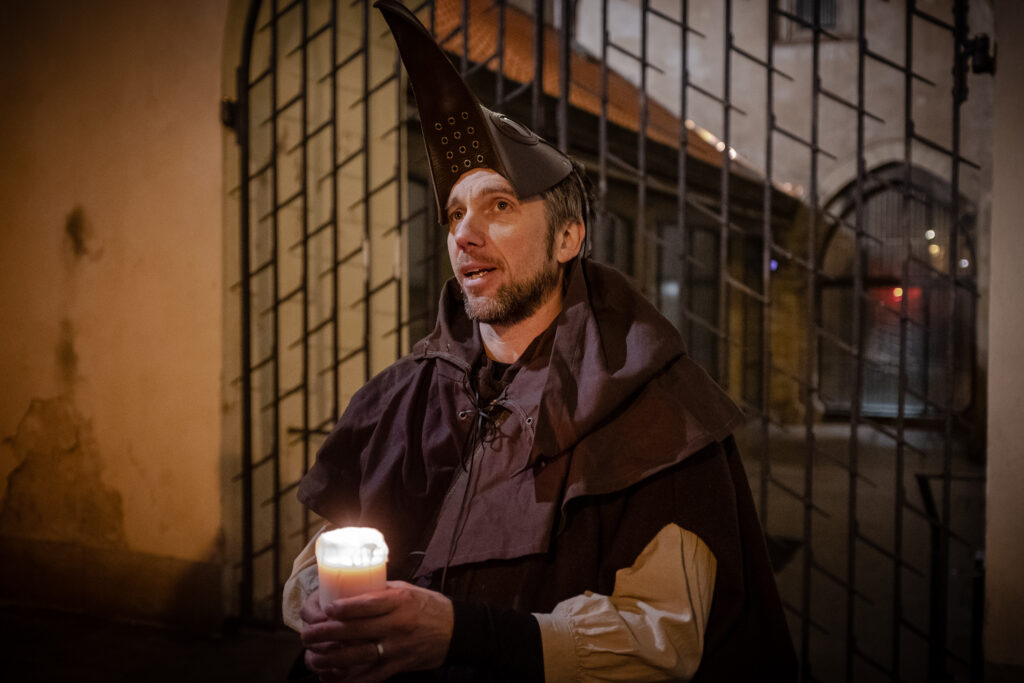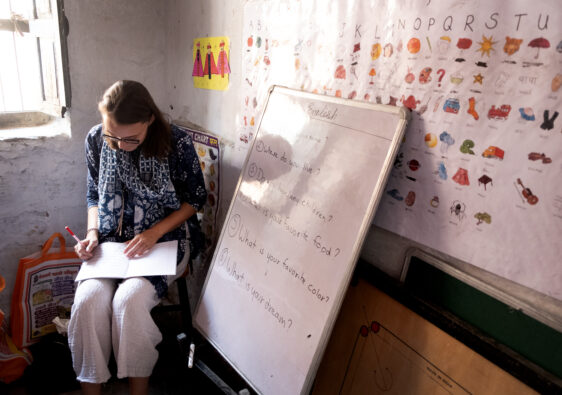“Three litres of beer laced with garlic was one of the early cures recommended by the plague doctor,” explained David Merton. “If people survived that I’d like to think they probably could survive the plague!.”
He is speaking about Dr. Alexandr Schamsky, Prague’s forgotten hero and the protagonist of the Plague Doctor tour through the streets of the Czech capital. During lockdown, he is conducting the tour as a virtual experience for the first time, and the parallels between the plague and the present-day COVID pandemic lend it added significance.
With a beer in hand, David transports us back to 1713 and the disease-infested streets of the Old Town. “Emperor Charles VI told the people that the plague was a heavenly punishment and that only prayer was the cure,” he explains. “Ironically, the churches were closed, so people gathered in groups around columns scattered throughout the city, unaware they were spreading the disease. At outbreak, plague columns were erected to thank God for ending the plague, which you can see today scattered throughout the city.”
A lover of history, beer, and beards, German-born David worked for many years as a drama teacher, so he has a flair for making history dramatic. “Schamsky lost both his parents to cancer and subsequently became obsessed with studying illness,” he continues. By age 20, Schamsky had gained his medical degree, and when the bubonic plague hit in 1713, he was ready to treat victims of the plague.
The tour starts at the medieval Charles Bridge and meanders toward the Jewish quarter. David discusses the history of Prague and the different statues along the way, including Ladislav Saloun’s The Iron Knight, which resembles a particular superhero. “Czech people like to think they invented Batman,” he says.
As the legend goes, the knight had gone off to fight in one of the many battles that raged in that era. When he returned, he heard a slanderous rumour that his betrothed had been unfaithful. I won’t tell you any more; I will leave that to David when you join his tour.
He also explains the history of this fascinating city, revealing little-known wonders in the dark streets. For instance, the old Jewish cemetery, founded in the first half of the 15th century, is Europe’s oldest surviving Jewish cemetery. It is still unknown how many bodies are buried there. There are 1,200 visible graves but 12 layers of tombs. The tour concludes at St Francis Hospital, which has over six centuries of history.
Just like our NHS doctors today who are treating people during the present pandemic, Doctor Schamsky and others showed unwavering dedication to their use of specific personal protective equipment. They wore gear that covered their whole bodies, including a large brown coat and a beak-like mask. David Just like NHS doctors today treating patients during the pandemic, Doctor Schamsky and others showed unwavering dedication to using specific personal protective equipment. Theycovered their entire bodies, including a large brown coat and a beak-like mask. David explained that the masks were filled with fresh herbs and straw in summer and spices during winter. They believed this would protect them from the putrid air in the homes and hospitals they entered. wore gear that explained to us that the masks were filled with fresh herbs and straw in the summer and spices throughout the winter. They believed this would protect them from the putrid air in the homes and hospitals they entered.
The doctors also carried a cane to examine and direct patients without touching them. Today’s doctors don’t use canes, but we have seen helmet-like protective gear that acts similarly to the masks worn in the 18th century. However, unlike the NHS staff today, Plague Doctors didn’t start washing their hands until the 18th century. Treatment was more about speed—getting through surgeries quickly. David’s idea of booking an early appointment in those days was a great recommendation!
David’s tour is a treasure trove of unique historical anecdotes. He regales us with the story of Robert Liston, a Scottish surgeon known as the fastest knife in town. In an era before anaesthetics, Liston’s patients were eager for their surgeries to be over quickly. Liston’s most famous feat? Removing a 45-pound tumour of the scrotum in a mere 4 minutes! The patient had been carting it around in a wheelbarrow before the operation – I can only imagine the mix of relief and shock he must have felt during those intense 4 minutes.
Schamsky died at 27 from the plague, and his name was forgotten. But now David is resurrecting his heroic acts. Throughout the tour, I’d be sipping away on a beer (as suggested by David) – lucky for me, the virtual element meant he couldn’t slip in a few cloves of garlic to test Schamsky’s old plague ridding-remedy.
David discusses the biology of the plague in detail. He explains that the surgeons of the time were more like craftsmen than medics ande died of infections after surgery than survived. Most startlingly, there wasn’t a cure for the plague for 500 years until the antibiotic was discovered in the 1940s. COVID-19 has only been around for six months, which puts our impatience into a whole new perspective. L that more peoplet’s hope we don’t need to wait another 500 years for a vaccine.
David’s tour is full of unexpected and amusing elements. He shares fascinating facts about rats, such as their ability to swim for 2 days straight and dive for 4 minutes at a time. He even jokes that he walks in front of the group to look out for rats when in reality, he’s on the lookout for dog poop. These unexpected and amusing moments make David’s tour so enjoyable.
David’s storytelling is not only informative but also infused with his unique sense of humor. He admits, “People are sometimes a bit scared on the tour, and that’s quite fun for me. My own sense of humour can be a bit special and quite dark, which seems to attract the English people,” he says with a chuckle.
I once received a great question that made me laugh a lot: “Did you ever consider infecting yourself with the plague to get a more immersive experience?”
“My answer, of course, was no, even though we have a cure now, so I could”.
At the end of the tour, David spoke a poem that encapsulated the spirit of the experience. The poem, ‘May angels watch me through the night, protect me to the morning’s light. Your plague doctor of Prague is here; enjoy yourselves and drink your beer,’ which serves as a reminder of the resilience and spirit of the people who lived through the plague. It’s a fitting end to a tour that has brought history to life.

Getting to Prague:Easyjet currently have flights from £48. Book the online tour:airbnb experiences Book the walk tour:https://night-watchman.net |



